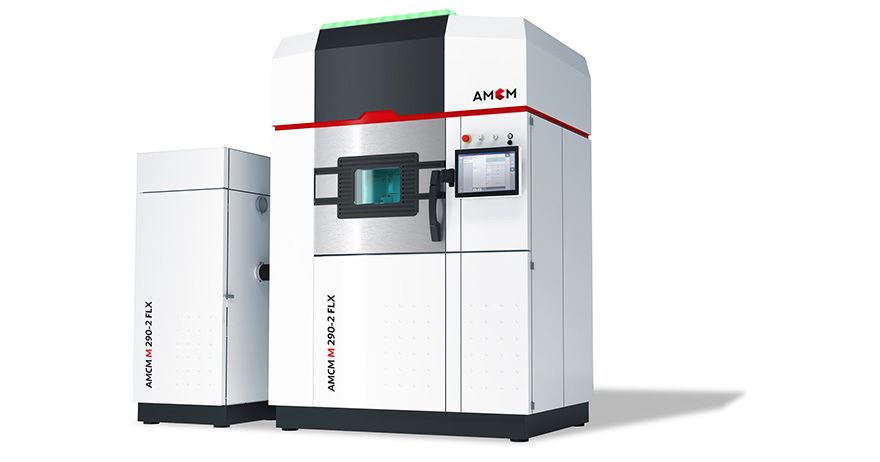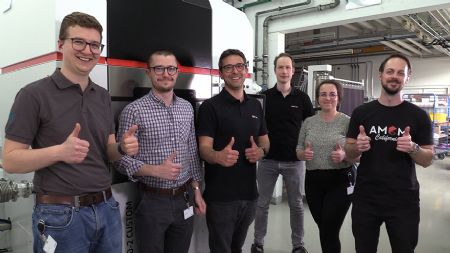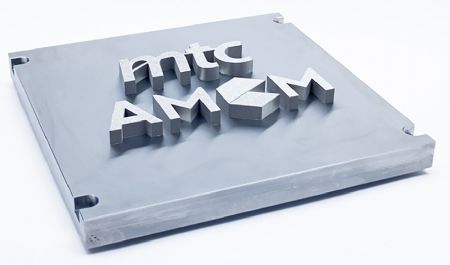
Coventry-based
Manufacturing Technology Centre (MTC) is an independent research and technology organisation, providing customers with easy and early access to the latest applied technologies and research. The MTC is the National Centre of Additive Manufacturing in the UK and is a focal point for AM research activities within the country.
The team specialises in developing advanced manufacturing processes and technologies to produce complex and large-scale AM components. MTC wanted a system that was flexible, industrially scalable and pushed the boundaries to enable step changes in novel materials development and productivity.
AMCM, whose sister company
EOS recently joined MTC as a Tier Three member, provides customised solutions beyond ‘state of the art’ standard systems based on industrialised EOS systems.
The AMCM M 290-2 FLX incorporates two nLIGHT AFX lasers, offering a variable laser spot from 85µm Gaussian to 210µm donut shape. This enables a wider and shallower melt pool with more uniform temperature distribution, resulting in faster printing with improved process stability, reduced soot, and spatter. The traditional approaches that have been used to date to solve these problems, such as beam defocusing, can have a detrimental effect on the focus profile and a negative impact on part quality and repeatability.
Full flexibilityThe 3-D printer offers a full field overlap, meaning both scanners can reach all spots on the build plate and full flexibility is possible with regards to build orientation. AMCM already showed a significant productivity increase with, for example, IN718 material. Compared to a standard single 400W laser process with 85µm spot size, a single nLIGHT exposure process is two-times faster in addition to having the same mechanical and surface properties, this is expected to be further improved with an additional laser source.
 Pictured right: The MTC team visiting AMCM Starnberg to receive comprehensive practical training on the machine before it is delivered. From left to right: Chris Dalton, Alex Hardaker, Marius Christ, Christoph Seyfert, Fiona Schulz and Marius Hoyer
Pictured right: The MTC team visiting AMCM Starnberg to receive comprehensive practical training on the machine before it is delivered. From left to right: Chris Dalton, Alex Hardaker, Marius Christ, Christoph Seyfert, Fiona Schulz and Marius HoyerGas flow and oxygen level are often the defining factors in PBF-LB processes quality. This is particularly true when speed is increased above a certain threshold or when oxidation-sensitive materials are used. As AMCM specialises in industrial solutions, its systems feature unique long-term stable atmosphere control at <50ppm. MTC will initially use the AMCM M 290-2 FLX for a comprehensive evaluation of pure copper printing, which is a challenging material when aiming for industrial quality and reliability.
Furthermore, the AMCM system can heat the build platform up to 500°C. As pre- and post-heat treatment is critical in the processing of certain high performance aluminum alloys and refractory metals, this enables MTC to evaluate a wide range of high-end applications, such as those in the aerospace and defence industry.
At the forefront of innovationSina Trik, sales – AMCM, EMEA, said: “The UK manufacturing sector is at the forefront of innovation. While the use of materials such as copper offers huge benefits to product designers, manufacturers still face challenges in the additive manufacturing process. It is always amazing to work with MTC — a true thought leader in UK — to expand the field of industrial metal AM.”
As well as exploring new materials, the MTC is also developing ways to increase the speed of AM production and the size of output components. Efficient exposure processes are needed to reduce time and costs. The variable spot sizes of nLIGHT can be switched within 30ms to print contours and fine structures with maximum precision and infill hatching with accelerated throughput.
 Pictured left: compared to a standard 400W laser process with 85µm spot size, the nLIGHT exposure process is two-times faster
Pictured left: compared to a standard 400W laser process with 85µm spot size, the nLIGHT exposure process is two-times fasterMuch like a master painter who uses different brushes for the large areas as opposed to the details, a larger spot size is also a good option for filling bulk material in additive manufacturing. After all, this allows you to generate more volume with each pass, significantly reducing the number of hatches and reversal points. Furthermore, the MTC will be investigating novel methods of reducing the need for post processing steps, such as heat treatment, through novel in-situ beam interactions and in process monitoring.
Equipped with two 1.2kW laser sources, the AMCM M 290-2 FLX is a high-power system, perfect for pushing the limits of speed and size. Ruaridh Mitchinson, technology manager at the MTC, said: “The laser setup will be identical to what is in future larger AMCM machines such as the AMCM M 8K. We will use our machine to investigate topics such as laser overlap on a smaller scale before going up to using larger systems. This investment demonstrates our continued support to companies by providing open access to assets with advanced AM capabilities that can produce high-performance parts more efficiently and cost-effectively. This way, we can help to increase the technology’s adoption in the UK.”